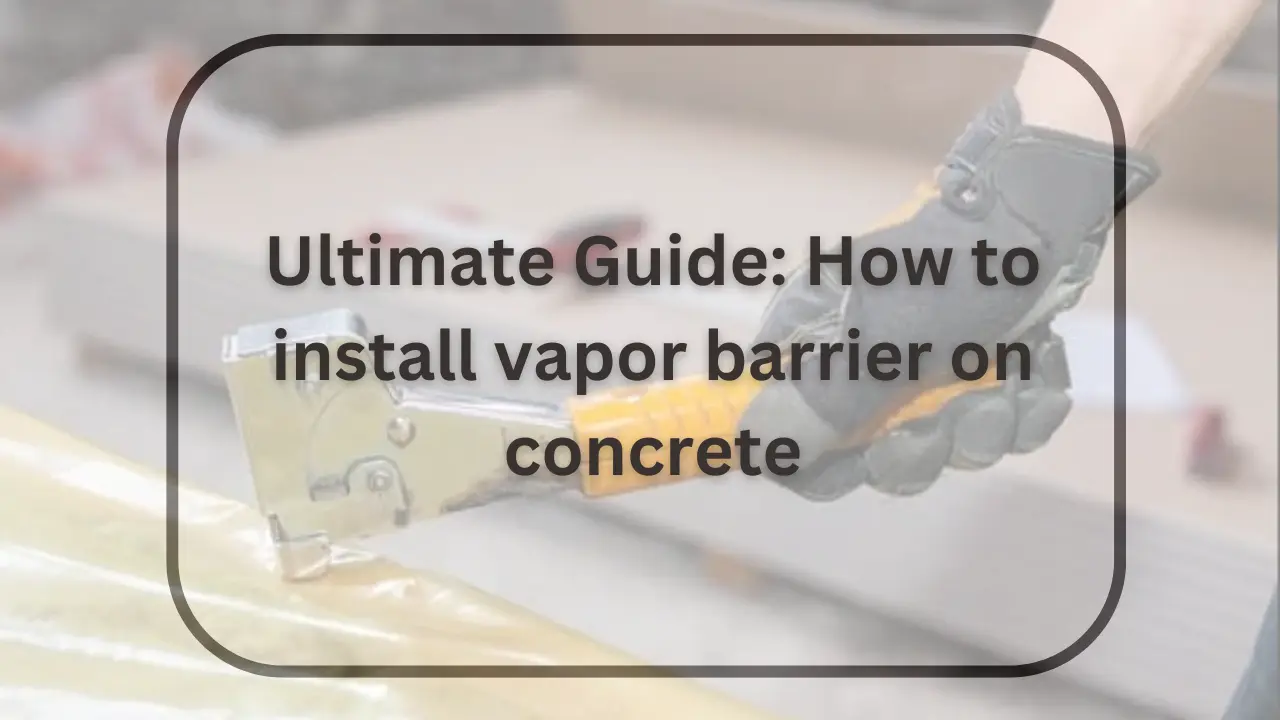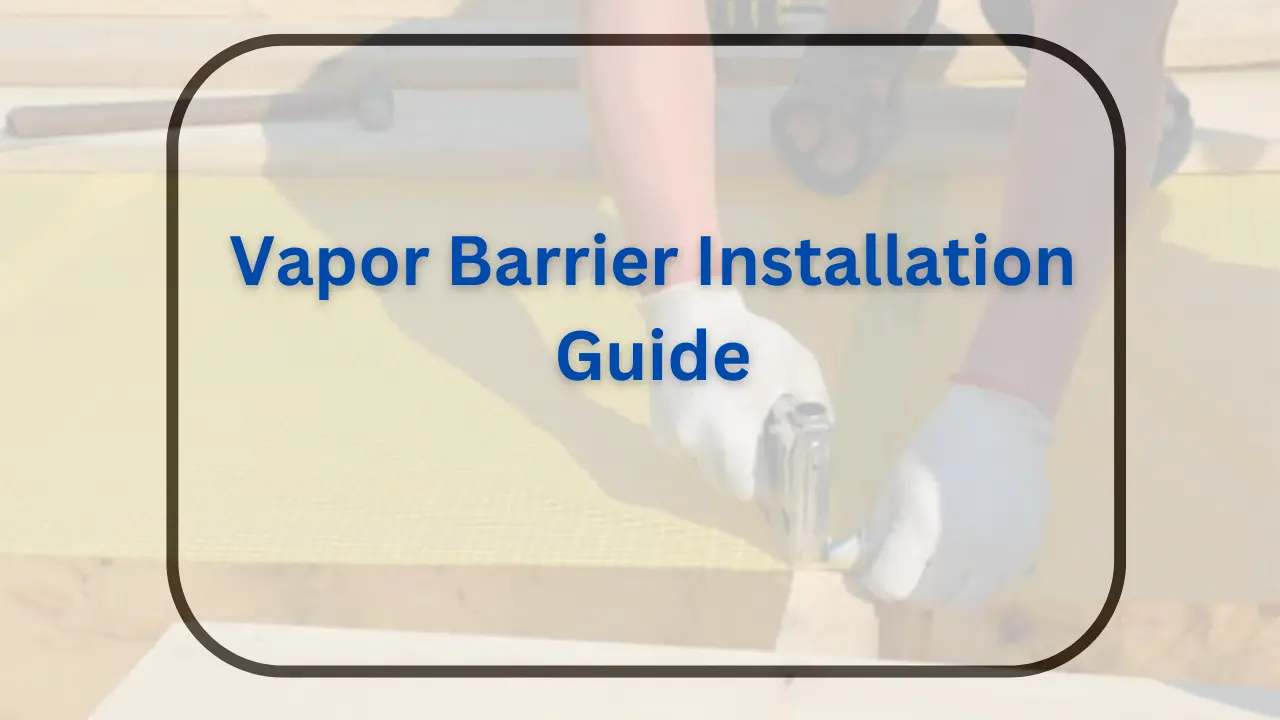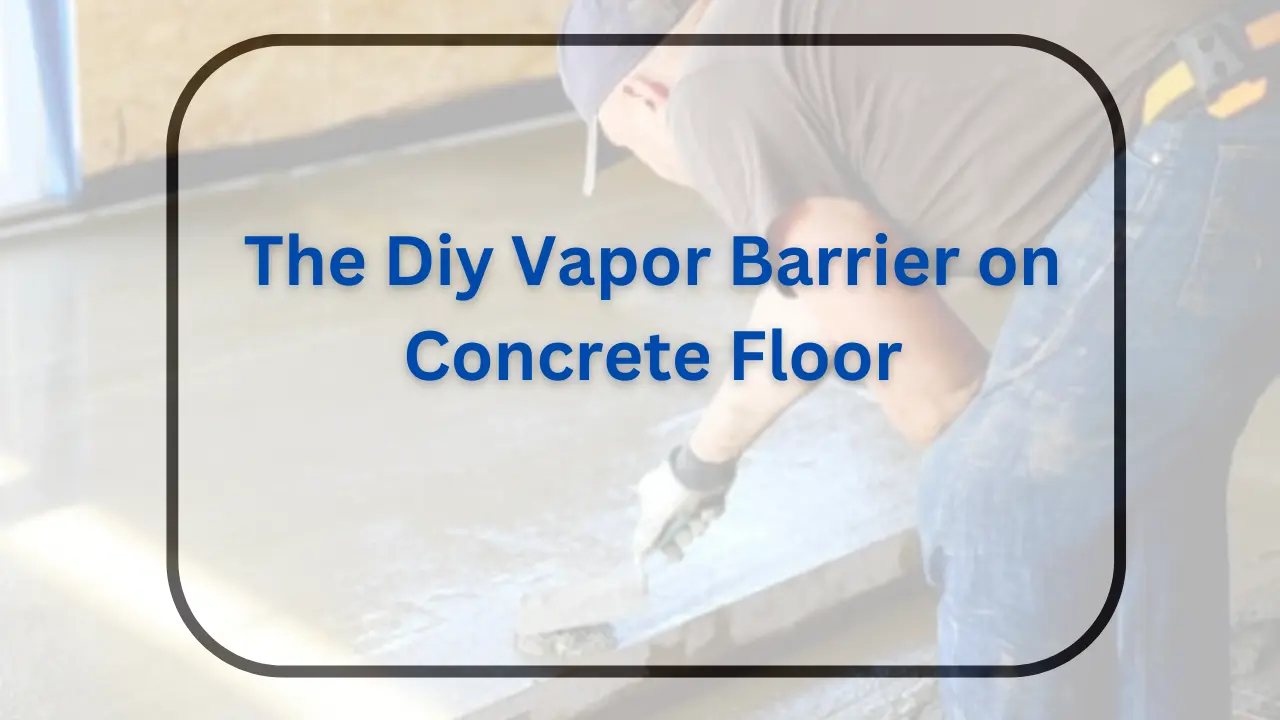Welcome to the ultimate guide on how to install vapor barrier on concrete! This blog post covers everything you need to know. It’s about installing a vapor barrier on concrete. We have best practices and step-by-step Best practices for vapor barrier installation guide. We also have DIY tips for securing your concrete floors.
Let’s cover the key techniques for installing vapor barriers well. Doing this will end moisture problems for good!
Best practices for vapor barrier installation
When installing a vapor barrier on concrete, follow best practices. They are crucial for long-lasting protection against moisture. Here are some key tips to keep in mind:
Understanding Vapor Barriers
Understanding vapor barriers is essential for protecting structures from moisture-related issues. A vapor barrier is a material designed to stop moisture vapor from moving from humid to dry areas. It stops it through walls, floors, or ceilings. It helps control moisture levels.
Builders use vapor barriers in buildings to stop moisture. It can penetrate walls, ceilings, or floors and cause damage. This damage includes mold, rot, and corrosion. They are key in humid areas. They are also key where indoor and outdoor temperature differences cause condensation.
When installing a vapor barrier, it’s crucial to consider factors. These include material choice, proper installation, and the building’s needs. There are many types of vapor barrier materials, including plastic sheeting, foil-faced insulation, and specialized membranes. The material choice depends on factors like climate, building design, and intended use.
Installing a vapor barrier involves sealing seams, overlaps, and holes. This creates a barrier that stops moisture. Also, ensure you put the vapor barrier on the warm side of the insulation. This stops condensation from forming in the building envelope.
Understanding vapor barriers is crucial. Effective moisture control is vital for maintaining building integrity and longevity. Vapor barriers can be used in construction and renovations. They help reduce the risk of moisture damage and make living and working spaces healthier and more durable.
Related Article: Step-by-Step: how to clean prefinished hardwood floors
Selecting the Right Vapor Barrier Material
Picking the right vapor barrier is key. It ensures good moisture control and protection for your project. When making your choice, you must consider many factors. They ensure the best performance and longevity.
, assess the material’s permeability. Aim for low permeability. It blocks moisture vapor from passing through walls, floors, or ceilings. It is also crucial that it works with your materials and conditions. They must fit for it to work well.
Durability is also critical. It withstands wear and tear. Flexibility helps with easier installation. This is especially true in challenging or irregular spaces. Also, check if the material meets fire safety standards. Also, check its environmental impact. This includes factors like recyclability and emissions.
Finally, consider the cost of the material over its lifespan. Balance initial expenses with long-term benefits and performance. By evaluating these factors, you can pick the best vapor barrier. It will protect your structure from moisture. This will ensure the structure’s integrity and longevity for years to come.
Related Article: how to prevent hardwood floor slipping
Preparing the Concrete Surface
Preparing the concrete surface is crucial. It ensures the success of your vapor barrier. Start by cleaning the concrete surface. Remove any dirt, dust, or debris that could interfere with adhesion. Fix any cracks or flaws in the concrete. This will make a smooth and even surface for the vapor barrier.
Next, check the moisture levels of the concrete using a moisture meter or moisture test kit. You must ensure the concrete is dry. Do this before installing the vapor barrier. It prevents moisture from getting trapped and causing damage.
If the concrete is not dry, you may need a sealer or moisture system. They reduce moisture before you install the vapor barrier.
Finally, inspect the concrete for any bumps or sharp edges. These could puncture the vapor barrier. Smooth out any rough spots or edges to create a seamless surface for the vapor barrier to adhere to.
Prepare the concrete surface before installing the vapor barrier. This will ensure a safe and effective installation. It will provide long-lasting protection against moisture.
Proper Sealing and Overlapping
Proper sealing and overlap are key. To install a vapor barrier, you need to use it. They ensure its effectiveness in stopping moisture. Start by sealing all seams and joints in the vapor barrier. Use a suitable method, like tape or adhesive. This creates a barrier. It stops moisture from getting through gaps or openings. Pay close attention to corners, edges, and any holes in the vapor barrier. Make sure to seal them tight.
Also, overlapping vapor barrier sections is critical. It creates a seamless barrier that maximizes protection against moisture. When sections overlap, make sure they cover any gaps. These are the gaps where moisture could seep. Seal seams and overlap sections of vapor barrier. This will improve the barrier and protect against moisture. It will preserve the integrity of your building.
Check Another Article: how to clean prefinished hardwood floors
Moisture Testing
Testing for moisture is crucial. It ensures the success of your vapor barrier on concrete. Before adding the vapor barrier, check the concrete’s moisture. This stops problems like mold, rot, or adhesive failure.
There are various methods for moisture testing, including:
- These are handheld devices. They measure the moisture at the surface of the concrete. They provide quick and easy-to-read results, making them suitable for preliminary assessments.
- This involves inserting probes into the concrete. They measure moisture levels at various depths. It provides more comprehensive data about moisture distribution within the concrete.
- Calcium Chloride Testing is a method. It involves putting calcium chloride crystals on the concrete surface. Then, you measure the rate of moisture absorption over a set time. It indicates the concrete’s moisture emission rate.
- This tests relative humidity. It measures levels in concrete using special probes in holes. It provides accurate data on the moisture conditions within the concrete.
Use any method you choose. But, make sure the concrete is dry before you install the vapor barrier. Thorough moisture testing lets you find and fix any moisture issues. This protects your vapor barrier system in the long term.
Vapor Barrier Installation Guide
Here’s a complete guide to installing a vapor barrier. It will help you keep moisture out of your space.
Step 1: Measure and Cut
Begin by measuring the dimensions of your space. Then, use these measurements to cut the vapor barrier to fit the area. Make sure it fits. Be sure to leave a slight overlap at seams and edges to create a seamless barrier. Precise measurement and cutting are crucial for a good vapor barrier. Take your time to ensure the dimensions are exact.
Step 2: Lay the Vapor Barrier
Once you have measured and cut the vapor barrier, lay it over the concrete. Start at one end. Unroll the vapor barrier. Make sure it lays flat and smooth with no wrinkles or creases. Work your way across the whole area. Adjust the barrier as needed for full coverage. Align the edges and seams. Keep the slight overlap to make a continuous barrier.
As you lay the vapor barrier, watch for obstacles or protrusions on the concrete. Make sure the barrier fits around them. Once the vapor barrier is in place. It’s ready for more securing and sealing. This finishes the installation process.
Step 3: Secure the Barrier
After laying the vapor barrier on the concrete, you must fasten it in place. This is to stop it from moving. Start by using staples or other fasteners. Use them to anchor the barrier along the edges and seams. Place the fasteners at regular intervals to ensure an even and secure attachment. Also, consider using adhesive or tape.
They will strengthen seams and overlaps, making a tight seal. Pay close attention to where the barrier meets walls or obstacles. Anchor it there too. Securing the vapor barrier is crucial. It keeps it effective at stopping moisture and preserving your space’s integrity.
Step 4: Trim Excess Material
Once the vapor barrier is in place, check its edges and seams. Look for any extra material that may stick out or overlap. Use a sharp knife or scissors to trim away extra material. Do this along the edges and seams to make a clean finish. Pay close attention to corners and tight spaces. Ensure that the vapor barrier fits against the concrete without any loose sections.
Trimming excess material makes sure the vapor barrier lays flat and smooth. This optimizes its ability to stop moisture. After trimming, check the whole barrier again. Make sure it is secure and sealed. It should be ready to offer long-lasting protection against moisture.
The DIY vapor barrier on concrete floor
You must protect your concrete floor from moisture. This is key to keeping it strong and long-lasting. Here’s how you can create a DIY vapor barrier:
Materials Needed
- 1. Vapor Barrier Material: Choose a suitable vapor barrier material. Options include plastic sheeting, vapor barrier membranes, and asphalt-coated kraft paper.
- 2. Utility Knife or Scissors: Use a utility knife or scissors. They are for cutting the vapor barrier to size and trimming excess.
- 3. Staples, Adhesive, or Tape: For securing the vapor barrier in place along the edges and seams.
- 4. Moisture Meter or Moisture Test Kit: Use a Moisture Meter or Test Kit. Use it to test the moisture levels of the concrete floor before installation.
- 5. Cleaning Supplies: Cleaning supplies include a broom, vacuum, or mop. They are for cleaning the concrete before installation.
- 6. Measuring Tape: It measures the size of the concrete floor and vapor barrier.
- 7. Protective Gear: Such as gloves and safety glasses to protect yourself during installation.
- 8. Optional: Concrete Sealer or Moisture Mitigation System: You may need a concrete sealer or a moisture mitigation system. This is if the concrete floor is too wet for a vapor barrier.
- Have all these materials on hand before starting. This will ensure a smooth and successful DIY vapor barrier installation.
Step-by-Step Installation
Step-by-Step Installation of DIY Vapor Barrier on Concrete Floor:
- Clean the Surface: Start by cleaning the concrete floor. This will ensure it is free from any dirt, dust, or debris. Use a broom, vacuum cleaner, or mop to remove any loose particles. This ensures a clean, smooth surface for the vapor barrier.
- Measure and Cut: Next, measure the dimensions of the concrete floor using a measuring tape. Transfer these measurements to the vapor barrier material and cut it to fit the size of the floor. Leave a slight overlap at the edges to ensure complete coverage.
- Lay the Barrier: Lay the pre-cut vapor barrier over the clean concrete floor. Start at one end and move across the whole floor. Smooth out any wrinkles or creases as you go to ensure the barrier lies flat and even.
- Secure in Place: Once the vapor barrier is in position, secure it along the edges and seams with staples, adhesive, or tape. Put the fasteners or tape at regular intervals. This will anchor the barrier to the concrete floor.
- Seal Joints: After securing the vapor barrier, seal any joints or overlaps. Use special vapor barrier tape or adhesive. This creates a continuous barrier. It stops moisture from seeping through gaps in the material.
- Trim Excess: Use a utility knife or scissors to trim extra material from the edges of the vapor barrier. Take care to achieve a neat finish. Ensure the barrier fits against the concrete floor.
- Inspect and Test: Inspect the installation. Check the vapor barrier for damage, gaps, or loose parts once you have finished it. Also, do a moisture test. It will show if the barrier is blocking moisture from the floor.
- Optional: Apply Concrete Sealer: You may apply a concrete sealer if the floor is moist. Do this or use a moisture system before adding the vapor barrier. This extra step can also reduce moisture intrusion. It can boost the vapor barrier’s effectiveness.
Follow these step-by-step instructions. With them, you can install a DIY vapor barrier on your concrete floor. It will protect against moisture and lengthen the life of your flooring.
FAQs
- How do I know if I need a vapor barrier on my concrete floor?
- If you notice moisture coming through the concrete. Or, if you have mold or mildew. We recommend using a vapor barrier to stop more damage.
- Can I install a vapor barrier over an existing concrete floor?
- Yes, you can add a vapor barrier over an old concrete floor. But, the surface must be clean and undamaged.
- What is the purpose of sealing the seams of the vapor barrier?
- Sealing the seams prevents moisture from seeping through gaps. It ensures the most protection against water.
- Do I need professional help to install a vapor barrier?
- You can do a DIY installation. But, consulting a professional can ensure proper installation and good moisture control.
- How long does a vapor barrier last?
- With proper installation and maintenance, a vapor barrier can last for several years. It provides long-term protection against moisture.
- Can I use a vapor barrier in conjunction with underfloor heating systems?
- Yes, you can use vapor barriers with underfloor heating systems. They stop moisture from reaching the heating elements.
Conclusion
In conclusion, putting a vapor barrier on concrete is critical. It protects your space from moisture problems. The guide covered proper prep and material choice. It also covered careful installation. It gave you detailed advice for a good vapor barrier installation.
This guide outlines a step-by-step process. It can help you protect your concrete floors from moisture. Doing so prevents damage such as mold, rot, and corrosion. You may be doing a DIY project or seeking professional help. Understanding vapor barriers’ importance is key. Using best practices will ensure your concrete lasts.
Remember, an installed vapor barrier has 2 benefits. It preserves the space’s structure. It also makes the indoor environment healthier and more comfortable. Don’t overlook this key part of construction and renovation projects. Investing in a vapor barrier now will save you time, money, and headaches later.







